Page 106 of 592
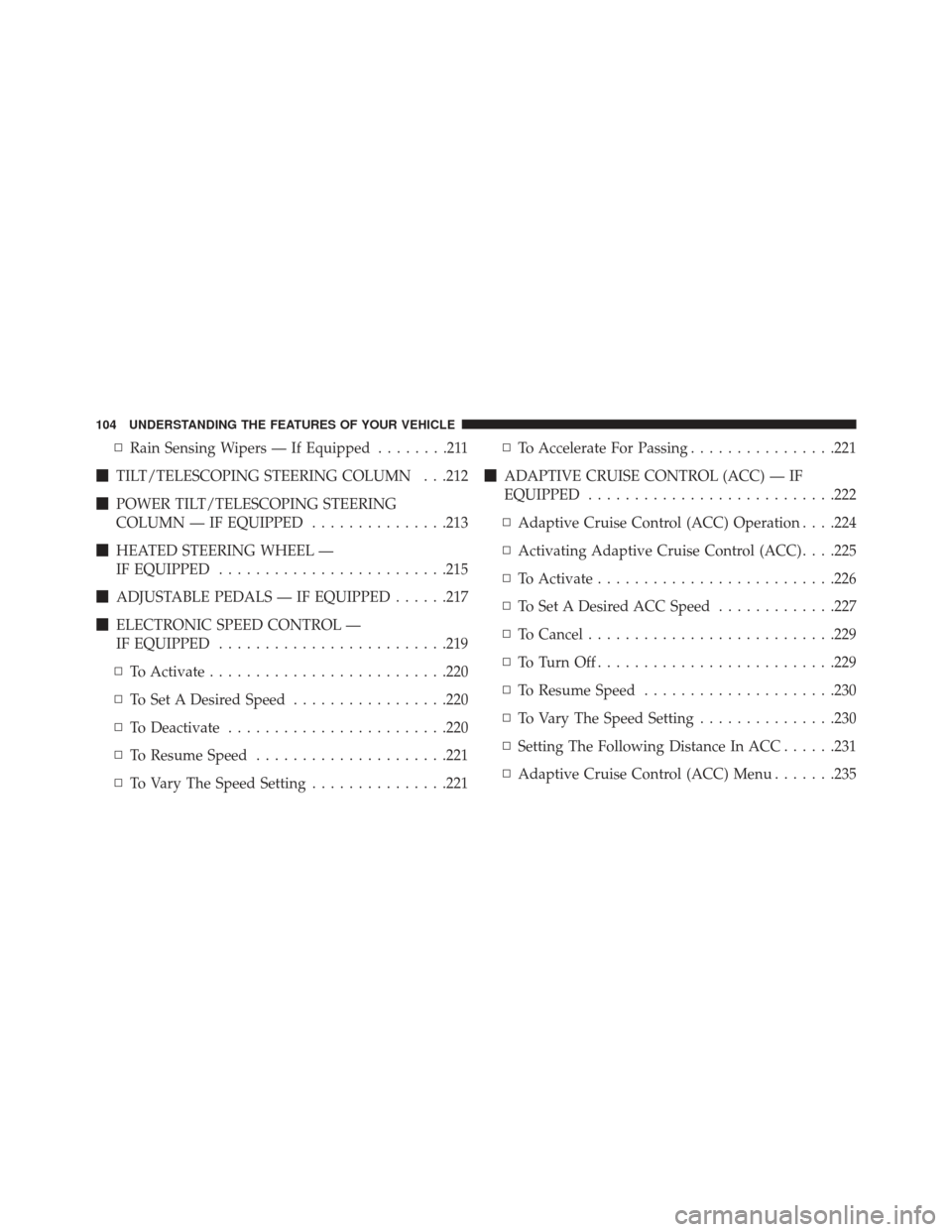
▫Rain Sensing Wipers — If Equipped ........211
� TILT/TELESCOPING STEERING COLUMN . . .212
� POWER TILT/TELESCOPING STEERING
COLUMN — IF EQUIPPED ...............213
� HEATED STEERING WHEEL —
IF EQUIPPED ........................ .215
� ADJUSTABLE PEDALS — IF EQUIPPED ......217
� ELECTRONIC SPEED CONTROL —
IF EQUIPPED ........................ .219
▫ To Activate ......................... .220
▫ To Set A Desired Speed .................220
▫ To Deactivate ....................... .220
▫ To Resume Speed .....................221
▫ To Vary The Speed Setting ...............221 ▫
To Accelerate For Passing ................221
� ADAPTIVE CRUISE CONTROL (ACC) — IF
EQUIPPED .......................... .222
▫ Adaptive Cruise Control (ACC) Operation . . . .224
▫ Activating Adaptive Cruise Control (ACC) . . . .225
▫ To Activate ......................... .226
▫ To Set A Desired ACC Speed .............227
▫ To Cancel .......................... .229
▫ ToTurnOff......................... .229
▫ To Resume Speed .....................230
▫ To Vary The Speed Setting ...............230
▫ Setting The Following Distance In ACC ......231
▫ Adaptive Cruise Control (ACC) Menu .......235
104 UNDERSTANDING THE FEATURES OF YOUR VEHICLE
Page 107 of 592

▫Display Warnings And Maintenance ........236
▫ Precautions While Driving With ACC .......238
▫ General Information ...................243
▫ Normal (Fixed Speed) Cruise Control Mode . . .243
▫ Forward Collision Warning — If Equipped. . . .245
� PARKSENSE® PARK ASSIST — IF EQUIPPED . .247
▫ ParkSense® Sensors ....................248
▫ ParkSense® Warning Display .............248
▫ ParkSense® Display ....................249
▫ Front Park Assist Audible Alerts ...........253
▫ Enabling And Disabling ParkSense® ........253
▫ Service The ParkSense® Park Assist System . . .253
▫ Cleaning The ParkSense® System ..........254▫
ParkSense® System Usage Precautions .......254
� PARKVIEW® REAR BACK UP CAMERA — IF
EQUIPPED .......................... .257
▫ Turning ParkView® On Or Off — With
Touch—Screen Radio ...................259
� OVERHEAD CONSOLE ..................259
▫ Front Map/Reading Lights ..............260
▫ Courtesy Lights ...................... .261
▫ Sunglasses Bin Door ...................261
� GARAGE DOOR OPENER — IF EQUIPPED . . . .262
▫ Before You Begin Programming HomeLink® . .263
▫ Programming A Rolling Code .............264
▫ Programming A Non-Rolling Code .........266
▫ Canadian/Gate Operator Programming ......267
3
UNDERSTANDING THE FEATURES OF YOUR VEHICLE 105
Page 220 of 592
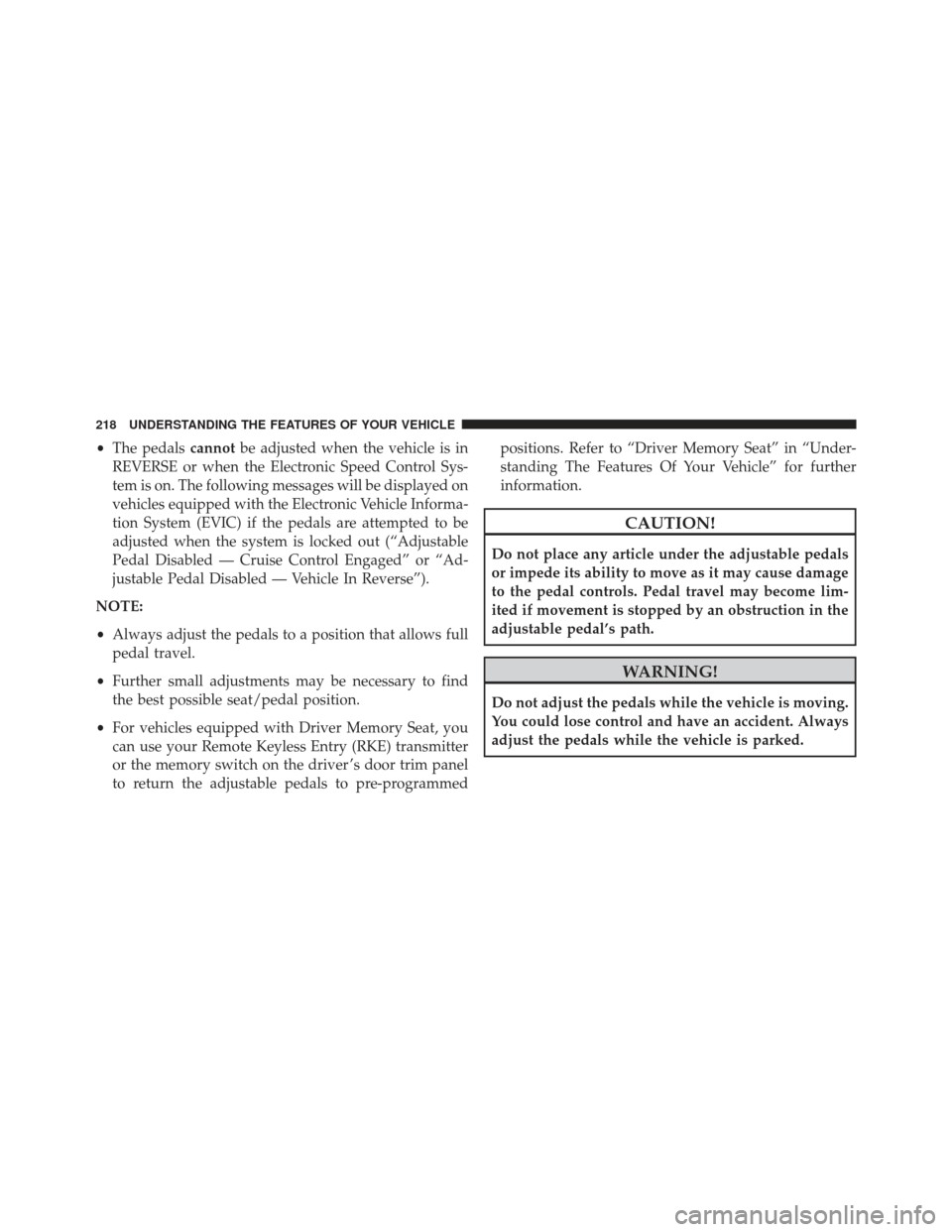
•The pedals cannotbe adjusted when the vehicle is in
REVERSE or when the Electronic Speed Control Sys-
tem is on. The following messages will be displayed on
vehicles equipped with the Electronic Vehicle Informa-
tion System (EVIC) if the pedals are attempted to be
adjusted when the system is locked out (“Adjustable
Pedal Disabled — Cruise Control Engaged” or “Ad-
justable Pedal Disabled — Vehicle In Reverse”).
NOTE:
• Always adjust the pedals to a position that allows full
pedal travel.
• Further small adjustments may be necessary to find
the best possible seat/pedal position.
• For vehicles equipped with Driver Memory Seat, you
can use your Remote Keyless Entry (RKE) transmitter
or the memory switch on the driver ’s door trim panel
to return the adjustable pedals to pre-programmed positions. Refer to “Driver Memory Seat” in “Under-
standing The Features Of Your Vehicle” for further
information.
CAUTION!
Do not place any article under the adjustable pedals
or impede its ability to move as it may cause damage
to the pedal controls. Pedal travel may become lim-
ited if movement is stopped by an obstruction in the
adjustable pedal’s path.
WARNING!
Do not adjust the pedals while the vehicle is moving.
You could lose control and have an accident. Always
adjust the pedals while the vehicle is parked.
218 UNDERSTANDING THE FEATURES OF YOUR VEHICLE
Page 222 of 592
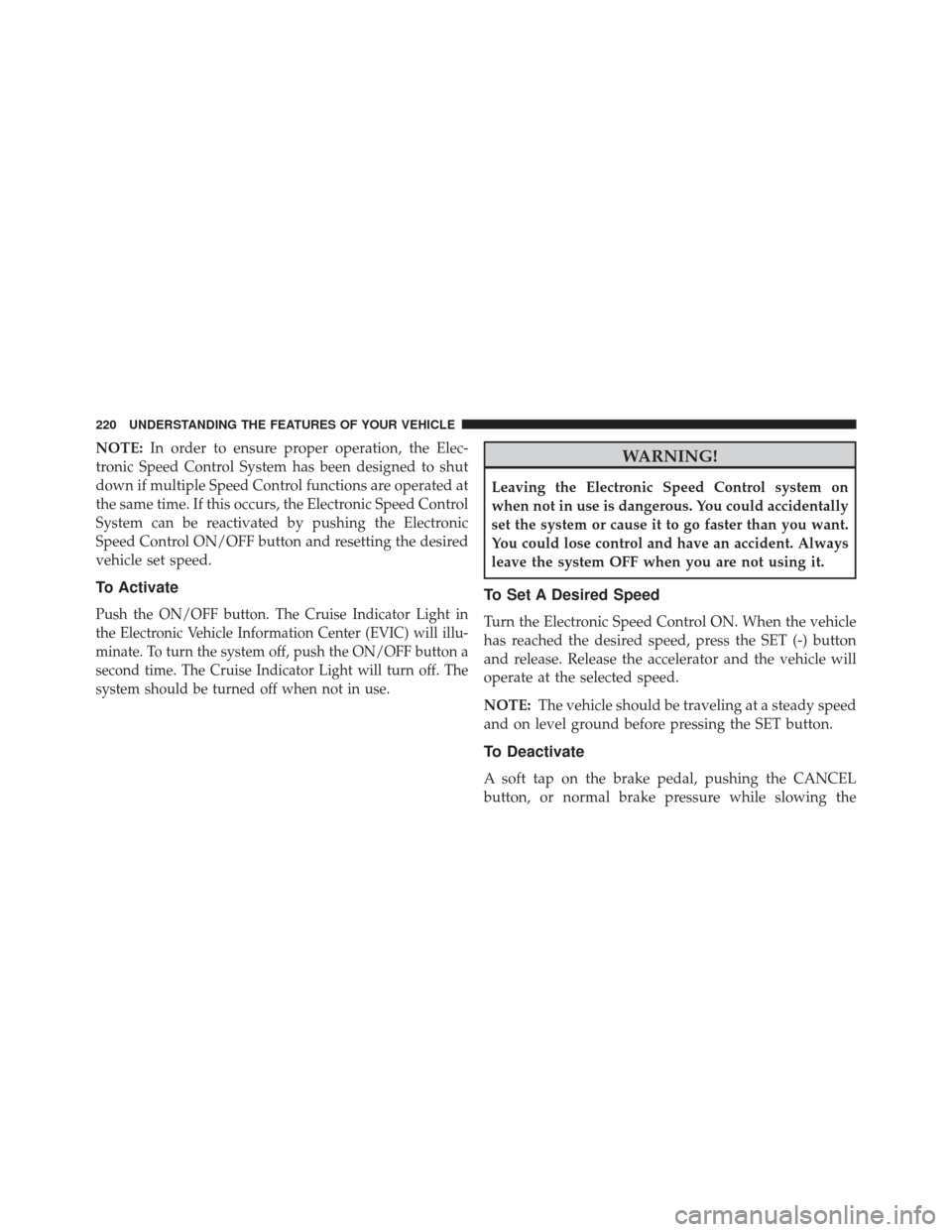
NOTE:In order to ensure proper operation, the Elec-
tronic Speed Control System has been designed to shut
down if multiple Speed Control functions are operated at
the same time. If this occurs, the Electronic Speed Control
System can be reactivated by pushing the Electronic
Speed Control ON/OFF button and resetting the desired
vehicle set speed.
To Activate
Push the ON/OFF button. The Cruise Indicator Light in
the Electronic Vehicle Information Center (EVIC) will illu-
minate. To turn the system off, push the ON/OFF button a
second time. The Cruise Indicator Light will turn off. The
system should be turned off when not in use.
WARNING!
Leaving the Electronic Speed Control system on
when not in use is dangerous. You could accidentally
set the system or cause it to go faster than you want.
You could lose control and have an accident. Always
leave the system OFF when you are not using it.
To Set A Desired Speed
Turn the Electronic Speed Control ON. When the vehicle
has reached the desired speed, press the SET (-) button
and release. Release the accelerator and the vehicle will
operate at the selected speed.
NOTE: The vehicle should be traveling at a steady speed
and on level ground before pressing the SET button.
To Deactivate
A soft tap on the brake pedal, pushing the CANCEL
button, or normal brake pressure while slowing the
220 UNDERSTANDING THE FEATURES OF YOUR VEHICLE
Page 224 of 592
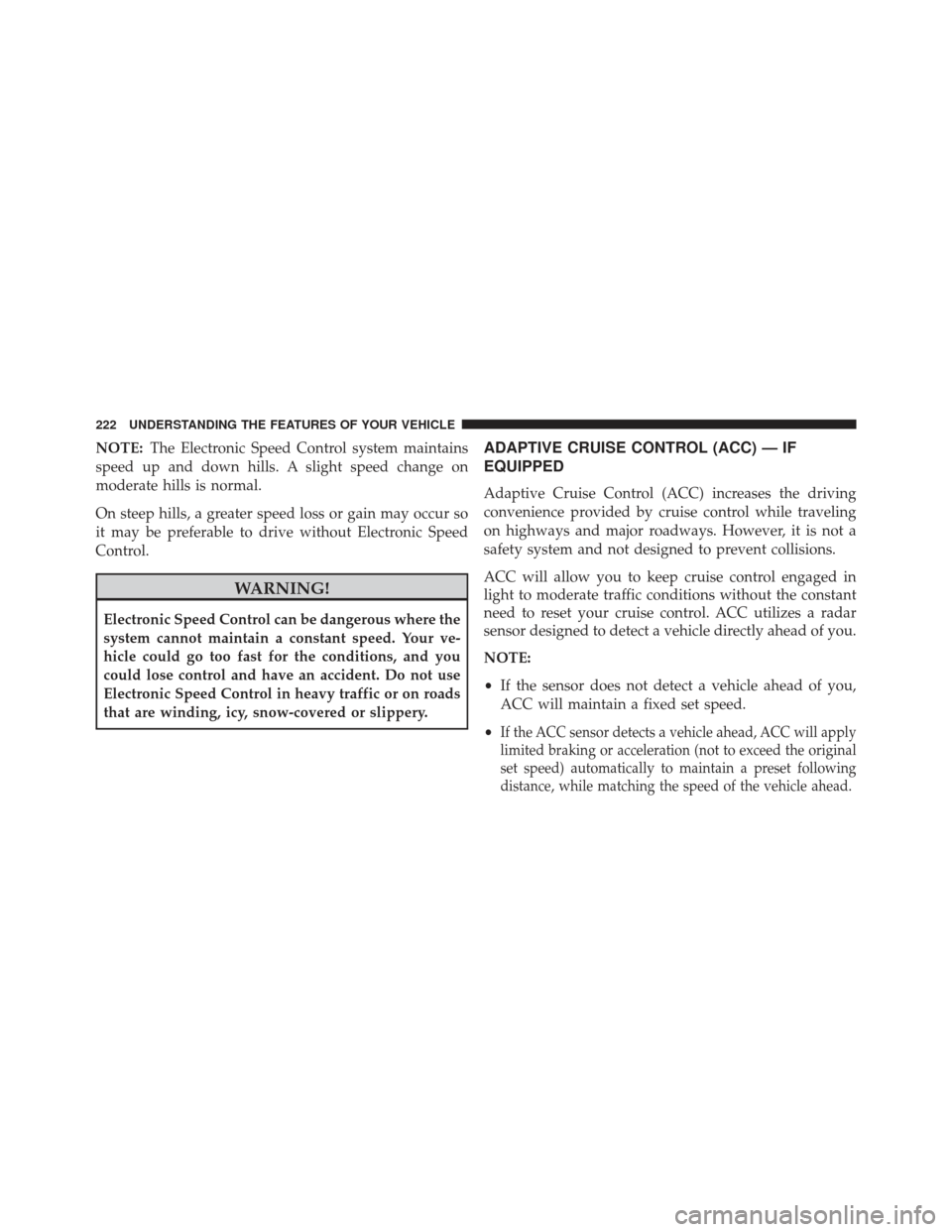
NOTE:The Electronic Speed Control system maintains
speed up and down hills. A slight speed change on
moderate hills is normal.
On steep hills, a greater speed loss or gain may occur so
it may be preferable to drive without Electronic Speed
Control.
WARNING!
Electronic Speed Control can be dangerous where the
system cannot maintain a constant speed. Your ve-
hicle could go too fast for the conditions, and you
could lose control and have an accident. Do not use
Electronic Speed Control in heavy traffic or on roads
that are winding, icy, snow-covered or slippery.
ADAPTIVE CRUISE CONTROL (ACC) — IF
EQUIPPED
Adaptive Cruise Control (ACC) increases the driving
convenience provided by cruise control while traveling
on highways and major roadways. However, it is not a
safety system and not designed to prevent collisions.
ACC will allow you to keep cruise control engaged in
light to moderate traffic conditions without the constant
need to reset your cruise control. ACC utilizes a radar
sensor designed to detect a vehicle directly ahead of you.
NOTE:
• If the sensor does not detect a vehicle ahead of you,
ACC will maintain a fixed set speed.
•
If the ACC sensor detects a vehicle ahead, ACC will apply
limited braking or acceleration (not to exceed the original
set speed) automatically to maintain a preset following
distance, while matching the speed of the vehicle ahead.
222 UNDERSTANDING THE FEATURES OF YOUR VEHICLE
Page 225 of 592
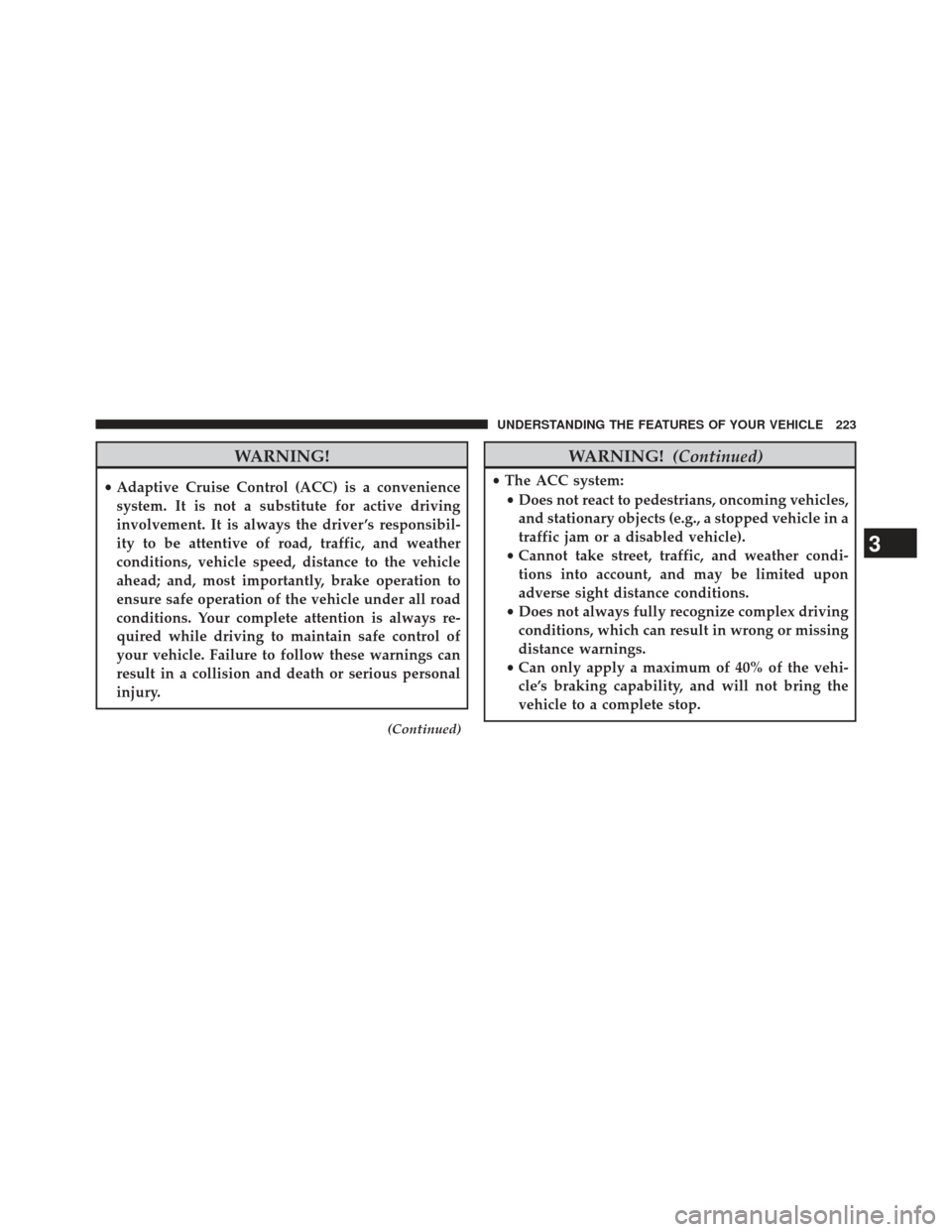
WARNING!
•Adaptive Cruise Control (ACC) is a convenience
system. It is not a substitute for active driving
involvement. It is always the driver ’s responsibil-
ity to be attentive of road, traffic, and weather
conditions, vehicle speed, distance to the vehicle
ahead; and, most importantly, brake operation to
ensure safe operation of the vehicle under all road
conditions. Your complete attention is always re-
quired while driving to maintain safe control of
your vehicle. Failure to follow these warnings can
result in a collision and death or serious personal
injury.
(Continued)
WARNING! (Continued)
•The ACC system:
• Does not react to pedestrians, oncoming vehicles,
and stationary objects (e.g., a stopped vehicle in a
traffic jam or a disabled vehicle).
• Cannot take street, traffic, and weather condi-
tions into account, and may be limited upon
adverse sight distance conditions.
• Does not always fully recognize complex driving
conditions, which can result in wrong or missing
distance warnings.
• Can only apply a maximum of 40% of the vehi-
cle’s braking capability, and will not bring the
vehicle to a complete stop.
3
UNDERSTANDING THE FEATURES OF YOUR VEHICLE 223
Page 226 of 592
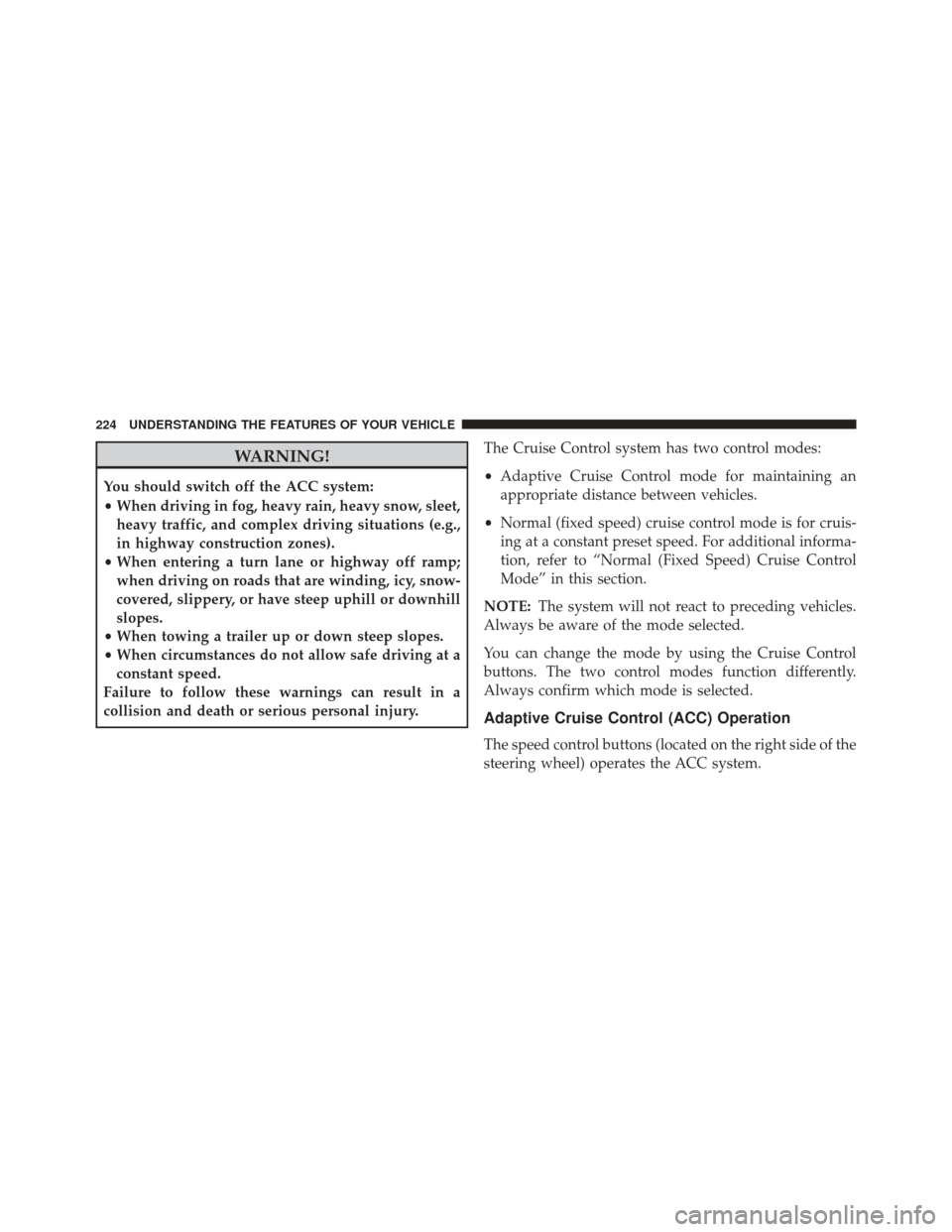
WARNING!
You should switch off the ACC system:
•When driving in fog, heavy rain, heavy snow, sleet,
heavy traffic, and complex driving situations (e.g.,
in highway construction zones).
• When entering a turn lane or highway off ramp;
when driving on roads that are winding, icy, snow-
covered, slippery, or have steep uphill or downhill
slopes.
• When towing a trailer up or down steep slopes.
• When circumstances do not allow safe driving at a
constant speed.
Failure to follow these warnings can result in a
collision and death or serious personal injury. The Cruise Control system has two control modes:
•
Adaptive Cruise Control mode for maintaining an
appropriate distance between vehicles.
• Normal (fixed speed) cruise control mode is for cruis-
ing at a constant preset speed. For additional informa-
tion, refer to “Normal (Fixed Speed) Cruise Control
Mode” in this section.
NOTE: The system will not react to preceding vehicles.
Always be aware of the mode selected.
You can change the mode by using the Cruise Control
buttons. The two control modes function differently.
Always confirm which mode is selected.
Adaptive Cruise Control (ACC) Operation
The speed control buttons (located on the right side of the
steering wheel) operates the ACC system.
224 UNDERSTANDING THE FEATURES OF YOUR VEHICLE
Page 227 of 592
NOTE:Any chassis/suspension modifications to the ve-
hicle will effect the performance of the Adaptive Cruise
Control.
Activating Adaptive Cruise Control (ACC)
You can only activate ACC if the vehicle speed is above
20 mph (32 km/h).
When the system is turned on and in the READY state,
the Electronic Vehicle Information Center (EVIC) dis-
plays “Adaptive Cruise Ready.”
When the system is OFF, the EVIC displays “Adaptive
Cruise Control Off.”
Adaptive Cruise Control Buttons
1 — DISTANCE SETTING
2 — RES +
3 — SET -
4 — CANCEL
5 — ON/OFF
6 — MODE
3
UNDERSTANDING THE FEATURES OF YOUR VEHICLE 225